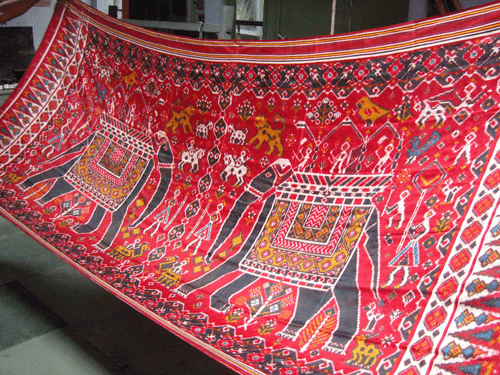Artistic Thread and Mirror Work in Gujarat Textile Industry

Gujarat is precisely famous for Garba, spicy food, Uttarayan, white desert, and unique culture. But what also showcase Gujarat extraordinary tradition is its textile industry. Gujarat textile industry is tremendous and has a stronghold in the Indian textile market. That is the primary reason why Gujarat is called the textile state of India. Most of its credit goes to the strong force of working laborers. They have been working for centuries to take the art and cultural heritage forward with the fast-moving textile industry internationally.
When spoken about Gujarat textiles, the first image that strikes our head is how they are colorful and glossy. These futuristic designs involving mirror and thread work in handloom clothes make them extraordinary. Women in India have a special place in their wardrobe for these colorful traditional designs, and they enjoy wearing them in ethnic as well as fusion trends.
The evolving fashion trend is bringing enormous experimenting with Indian as well as western wear. In this fashion, Gujarat textile has been blending phenomenally through adding thread and mirror work in western clothing. Young audience love the colorful thread and mirror work in Saree, jackets, shirts, shorts, skirts, tops and, bottoms. With these unique ideas of blending western and ethnic designs, Gujarat textile has been keeping up with the latest trends and doing remarkable business. Mirror and thread work in clothing, jewelry, and footwear is indeed specialty in the Indian handicrafts industry.

Who does traditional handloom work?
Gujarat textile industry has tremendous involvement of tribal workers since centuries. This group of tribal workers is called Rabari, Mutava, and Garasia Jat. They have the speciality in making traditional clothes, jewellery and footwear with exceptional thread and mirror work. At present, there are thousands of tribal handloom workers involved in the Gujarat textile market. They are working for years and passing on the heritage of artistic handloom for generations. They work for handloom factories of Gujarat as well as run the business themselves by travelling across India uplifting the traditional mirror and thread designs.
The weavers work spectacularly starting from collecting the raw material to make the thread, dyeing to washing. They use natural as well as the artificial colour of good qualities to make threads colourful and bright. The thread and mirror have a strong customer base in India and other countries mainly because of the unique, colourful and bright designs. The fast-moving fashion trend has led to secure support from pre-eminent fashion designers of the industry. With this sole effort, weavers can attain stable wages.

Why thread and mirror work is special?
Threadwork appears in various styles from various regions in India. Famous thread works, including Aari, KashidakariZardozi, Phulkari, Kantha, and Chikankari, have a tremendous fan following in India as well as across the globe. These designs of excellent thread work are time taking and worthwhile in every aspect. The colorful threads used for the job are of prime quality. Handloom threadwork has a significant influence on evolving fashion trends. In the Gujarat textile industry, most of the thread work is hand-woven.
The mirror work is precisely famous in Gujarat, and it is popularly called Sheesha. These tiny mirrors are embroidery done spectacularly with care and precision. This artistic handicraft design is accessible for the past few centuries since the ruling of Mughal’s empire. Workers, as well as women of the tribe, wear such clothes with thread and mirror work enthusiastically. The mirror work in saree, skirts, jackets, kurta and other apparel is popular. Indian handicrafts have thread and mirror work commonly in clothes, home decor, jewelry, and footwear. The influence of handicraft indeed reflects how people there admire to portray their culture in the best way possible.

Reflection of Gujarat in thread and mirror work
Rann Utsav is especially famous in Kutch of Gujarat. The grand festival is precisely renowned for the celebration of its traditional art and culture of every form. The form of art and culture include dance, Indian handicrafts, food, textile, jewelry, and home decor. People visit Gujarat, mainly to attend the festival from over India as well as the world. The festival is a massive platform where tribal handloom weavers come and showcase their exquisite Indian handicrafts. The festival is famous since 2005, and it has been boosting the art and culture of the state since then. Since the tragic earthquake shattered the business, Rann Utsav has massive contribution in uplifting the spirit of weavers and industry.